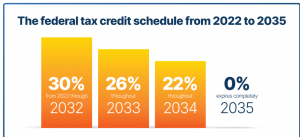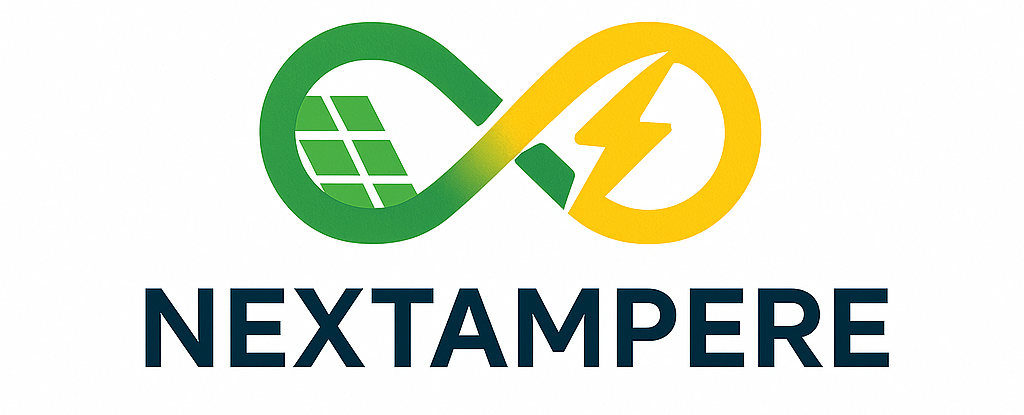The Federal Solar Tax Credit: How it Works in 2025
Written by Nextampere
Solar Investment Tax Credit (ITC)
The federal Solar Investment Tax Credit (ITC) has been a key driver of solar energy expansion in the United States. Since its introduction in 2006, this policy has fueled industry growth of more than 200 times nationwide.
Homeowners who install solar panels or qualifying clean energy equipment may qualify for the federal Residential Clean Energy Credit, commonly known as the solar tax credit. This program allows you to claim 30% of your installation costs as a credit, significantly reducing the amount of federal taxes you owe.
Fast Facts
- Under Section 25D of the tax code, individuals who install solar panels on their homes can receive a 30% federal tax credit.
- For businesses, Section 48 offers a similar 30% incentive for both on-site and large-scale solar projects. After Treasury guidance on wage and apprenticeship rules, the base benefit will fall to 6%, but projects meeting labor standards can still receive the full 30%.
- Section 48 projects may qualify for additional “adder” credits: 10% for using U.S.-made components, 10% for being located in energy communities, and up to 20% for construction in low-income areas.
- Commercial entities can alternatively claim a Production Tax Credit (PTC). This is valued at 1.5 cents per kilowatt-hour (currently 2.6 cents with inflation adjustments), but will shrink to 0.3 cents unless labor standards are met.
- Since its introduction in 2006, the ITC has driven explosive industry growth—over 200 times larger today, averaging 33% annual expansion over the past ten years.
- Section 48 credits require projects to meet a “begin construction” threshold, clarified by IRS guidance issued in 2018. This does not apply to the residential Section 25D credit.
- The ITC extension in 2022 has boosted investor confidence, enabling long-term projects that foster competition, innovation, and lower consumer prices.
- Despite these advances, solar still provides only about 3% of U.S. energy production.
- Policymakers emphasize that a stable tax framework is vital for scaling solar and energy storage in future infrastructure and decarbonization plans.
How the Solar ITC Has Shaped the Industry
As one of the most influential federal incentives for renewable energy, the ITC has fueled significant solar growth across the United States. Both small-scale and large-scale installations have expanded quickly under this framework. The stability of the program has given businesses the confidence to invest and lower costs over time. The ITC is widely viewed as a policy success, helping to build a cleaner grid and a stronger economy.
How the Solar ITC Works
At present, the Investment Tax Credit provides a 30% federal tax credit for qualifying solar projects. Residential systems fall under Section 25D, allowing homeowners to offset their personal income taxes with the credit when they install solar panels. For commercial and utility-scale systems under Section 48, the company that develops, installs, or finances the project is the one eligible to claim the benefit.
Unlike a deduction, a tax credit reduces federal income taxes dollar for dollar. The credit amount is tied to the level of investment in solar property. Under current law, the ITC will continue according to the following schedule:

Commercial and utility-scale projects that have commenced construction before December 31, 2023, may still qualify for the 26 or 22 percent ITC if they are placed in service before January 1, 2026. The IRS issued guidance (Notice 2018-59) on June 22, 2018, that explains the requirements that a taxpayer must meet to establish that construction of a qualified solar facility has begun for purposes of claiming the ITC.
To find out more information on the federal solar tax credit and calculate the credit amount per year based on household income, Solar-Estimate has a tax incentive calculator and additional detailed information.
Solar on New Residential Homes
If a homeowner buys a newly built home with solar and owns the system outright, the homeowner is eligible for the ITC the year that they move into the house. If the homeowners lease the solar system or purchase electricity from the system through a power purchase agreement (PPA), then the ITC is claimed by the company that leases the system or offers the PPA.
Will Donald Trump End the 2025 Solar Tax Credit?
Many people thinking about installing solar panels wonder whether the Trump administration might cancel the federal solar tax credit before 2025. Although this is a common concern, the chances of it happening are very low.
Tax credits are established by federal law, and any changes would require congressional action. So far, there has been no sign that lawmakers intend to reduce or eliminate the credit. Taking away a financial incentive that homeowners are already relying on would also be politically unpopular.
Given its strong history of bipartisan support, it is very likely the solar tax credit will continue to be available in 2025.

